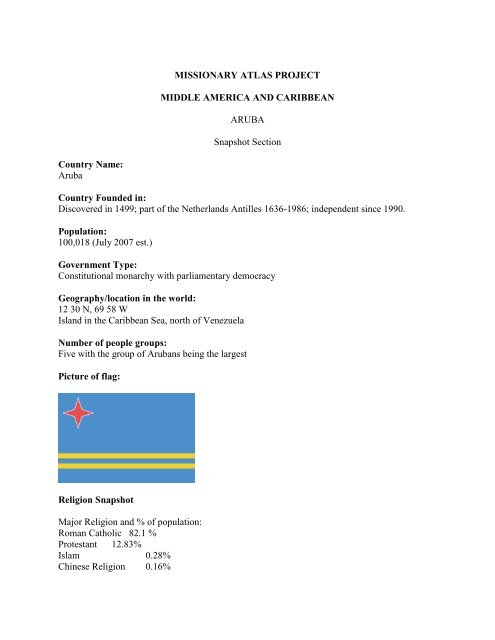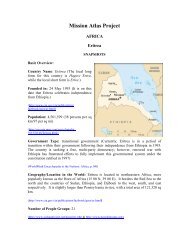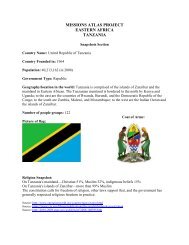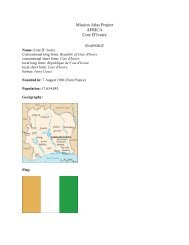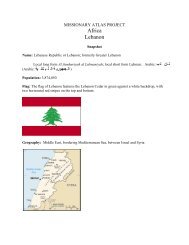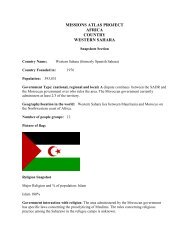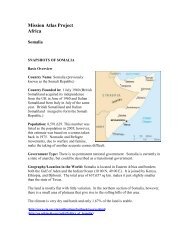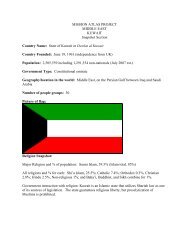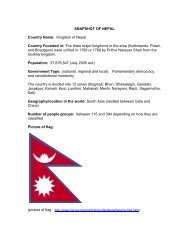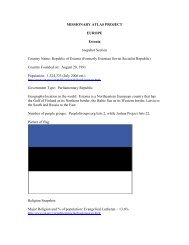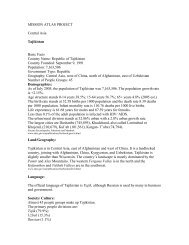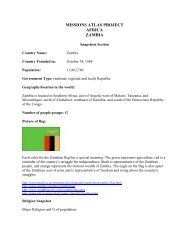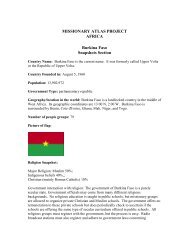ARUBA Profiile.pdf - WorldMap
ARUBA Profiile.pdf - WorldMap
ARUBA Profiile.pdf - WorldMap
You also want an ePaper? Increase the reach of your titles
YUMPU automatically turns print PDFs into web optimized ePapers that Google loves.
MISSIONARY ATLAS PROJECT<br />
MIDDLE AMERICA AND CARIBBEAN<br />
<strong>ARUBA</strong><br />
Snapshot Section<br />
Country Name:<br />
Aruba<br />
Country Founded in:<br />
Discovered in 1499; part of the Netherlands Antilles 1636-1986; independent since 1990.<br />
Population:<br />
100,018 (July 2007 est.)<br />
Government Type:<br />
Constitutional monarchy with parliamentary democracy<br />
Geography/location in the world:<br />
12 30 N, 69 58 W<br />
Island in the Caribbean Sea, north of Venezuela<br />
Number of people groups:<br />
Five with the group of Arubans being the largest<br />
Picture of flag:<br />
Religion Snapshot<br />
Major Religion and % of population:<br />
Roman Catholic 82.1 %<br />
Protestant 12.83%<br />
Islam 0.28%<br />
Chinese Religion 0.16%
Baha‟i 0.14%<br />
Judaism 0.14%<br />
Non-Religious/other 2.83%<br />
Government interaction with religion:<br />
The government allows complete freedom of religion and government respects this right.<br />
http://www.worldstatesmen.org/Aruba_const.<strong>pdf</strong> (Article I.1 of the Aruba Constitution)<br />
Sources consulted:<br />
Patrick Johnstone and Jason Mandryk, Operation World, 21 st Century Edition. Updated and Revised<br />
(Harrisonburgh: R. R. Donnelley & Sons, 2005)<br />
www.peoplegroups.org<br />
https://www.cia.gov/library/publications/the-world-factbook/print/aa.html<br />
http://www.state.gov/r/pa/ei/bgn/22491.htm
Country Profile<br />
Basic Facts<br />
Country Name:<br />
Aruba<br />
Population:<br />
In July 2007, Aruba‟s population numbered 100,018. The population density was 518.23 people<br />
per sq km.<br />
The age structure in July 2007 was as follows:<br />
0-14 years: 19.7% (male 9,943/female 9,761)<br />
15-64 years: 70.2% (male 33,553/female 36,661)<br />
65 years and over: 10.1% (male 4,046/female 6,054)<br />
The median age for the total population was 37.3 years (male 35.5 years/female 39 years). The<br />
life expectancy at birth for the total population was 74.83 years (male 71.8 years/ female 77.91<br />
years).<br />
With a birth rate of 12.83 births/1,000 population, a death rate of 7.61 deaths/1,000 population,<br />
and a net migration rate of 10 migrants/1,000 population, Aruba‟s population growth rate for<br />
2007 was 1.522%. The 2007 estimated infant mortality rate was 14.75 deaths/1,000 live births<br />
(male 19.59 deaths/1,000 live births; female 9.81 deaths/1,000 live births). The total fertility rate<br />
was 1.85 children born/woman.<br />
The sex ratio for 2007 was as follows:<br />
At birth: 1.02 male/female<br />
Under 15 years: 1.019 male/female<br />
15-64 years: 0.915 male/female<br />
65 years and over: 0.668 male/female<br />
Total population: 0.906 male/female<br />
Aruba's population is made up of a broad international mixture of well-educated people. The<br />
Aruban‟s mixed ancestry claims people groups from Caquetio Indian, African and European<br />
roots. Individuals from all over the world are attracted to Aruba due to its strong economy,<br />
excellent living conditions, and delightful weather.<br />
Language:<br />
Dutch and the native language of Papiamento are the two official languages of Aruba, but most<br />
Arubans speak a minimum of four languages including English and Spanish.<br />
In Aruba there are 5,289 Dutch native speakers (5.3%). The Dutch (alternative names are<br />
Nederlands or Hollands) classified as Indo-European, Germanic, West, Low Saxon-Low
Franconian, and Low Franconian language. Besides Netherlands and Aruba, Dutch is also<br />
spoken in countries such as Belgium, France, Germany, Indonesia, Netherlands Antilles, and<br />
Suriname. Even though Dutch is an official language in Aruba, it has been declining in use in<br />
the last decades.<br />
According to 1999 census, there are 60,000 native speakers of Papiamento (6%). The<br />
Papiamento language (alternative names are Papiam, Curaçoleño, Curassese, Papiamentoe) is<br />
believed to symbolize friendliness with its unique sayings and mannerisms and has been in use<br />
for over 300 years. It developed from an essentially pidgin language classified as Afro-<br />
Portuguese Creole (or Creole, Iberian based). The first use in official documents of Papiamento<br />
is found in the early 18 th century. The language then was used for the purposes of<br />
communication among peoples with different native languages.<br />
Through the middle of the 19 th century Papiamento was chosen for written documents that also<br />
included school books and Roman Catholic hymnals. Ultimately, Papiamento grew into the<br />
more complex modern language with expansion in syntax and lexicon. Though the language<br />
borrowed much from Dutch, English and Spanish, Papiamento still possesses its own unique<br />
rhythm and meanings. If it was not for the Dutch Crown to require solely the use of Dutch<br />
language in the school system, Papiamento would have continued to be used as the language of<br />
instruction.<br />
The first newspaper in Papiamento language, “Civilisado” (The Civilizer), was issued in 1871<br />
and the first Bible in Papiamento language was published in 1997. Papiamento, together with<br />
Dutch, was declared Aruba's official language only in March 19, 2003. Using Papiamento and<br />
Dutch does not indicated lack of education; however, inability to speak Dutch leads to<br />
dissatisfaction and hinders social and political mobility.<br />
English, classified as Indo-European, Germanic, West, English language, is spoken by 3,000<br />
(3%) natives in Aruba and is also known as Aruban English dialect.<br />
Spanish (alternative names are Español, Castellano, Castilian) is also classified as Indo-<br />
European, Italic, Romance, Italo-Western, Western, Gallo-Iberian, Ibero-Romance, West Iberian,<br />
Castilian language. Total number of Spanish speaking people in Aruba indicates 12.6%<br />
according to the CIA government library.<br />
http://www.cia.gov/library/publications/the-world-factbook/print/aa.html<br />
According to the 2000 census, there are also other languages (2.2%) as well as unspecified or<br />
unknown (5.3%).<br />
http://www.cia.gov/library/publications/the-world-factbook/print/aa.html<br />
Society/Culture:<br />
Aruba has a kaleidoscope of different cultures who, through the years, have contributed<br />
enormously to the development of the country from architectural designs to variety of cuisines.
These are immigrants from Caribbean islands, Colombia, Peru, Venezuela, as well as different<br />
African countries, China, and Philippines. Despite this multi-cultural and rich background,<br />
Arubans have a strong national identity which is marked by the high standard of living,<br />
successful economy, and a strong educational system. Being a relatively wealthy island and<br />
striving for separation for many decades, in 1986 Aruba became an autonomous country within<br />
the Dutch Kingdom.<br />
The large number of immigrants primarily from Colombia, Venezuela, Peru, other Caribbean<br />
islands, as well as from China, Philippines, and 17 different African countries together with<br />
native citizens, share a common strong national identity which is sustained by the successful<br />
economy, strong educational system, and with Aruban people enjoying one of the highest<br />
standards of living on the Caribbean. Multi-cultural mix that reflects a rich past in the peoples of<br />
Aruba marks the look of the people, the languages they speak, and the innate hospitality that they<br />
express through local foods, architecture, celebrations, and peacefully living together.<br />
A growing number of children attend day-care centers before going to school. The educational<br />
system is based on the Dutch model. Children attend kindergarten at the age of 4. When they<br />
turn 6, they are enrolled to the primary school and then after the age of 12, they enroll in<br />
secondary or lower vocational school.<br />
Pedagogical institute of Aruba provides higher education. The national system of education is<br />
heavily supported by the government and these educational programs are (1) primary school<br />
education - 23 nursery schools, 32 primary schools, and 23 schools for secondary education, (2)<br />
vocational training (LTO), basic education (MAVO), college preparation (HAVO), advanced<br />
placement (VWO), and the higher education through the Professional Education program.<br />
Private schools, such as the International Schools of Aruba (ISA), search for financial funding by<br />
their own means. Aruba takes after U.S. system in designing a hotel education. This is an<br />
education and training in hospitality and lodging industries including hotels, inns, and bed &<br />
breakfasts. Since the educational options of the country are limited, many students choose to<br />
study in North and South America as well as Europe.<br />
A development project called Enseñanza pa Empleo (Education for Employment) is co-financed<br />
by the Aruban and the Dutch governments and a great number of for-profit institutes. The<br />
project provides education for adults, which has been very popular among Arubans.<br />
Even though extramarital and premarital relationships are common, monogamy and legal<br />
marriage are the norm. Traditionally, Arubans favor interethnic marriages. However, in the<br />
recent years marriages to foreign spouses has increased drastically – 1991 census showed 45.2%<br />
of Aruban-born men married foreign spouses and likewise 24.8% of Aruban women married<br />
non-Arubans. The great number of these marriages caused by so-called of marriage of<br />
convenience (“fake marriage”) in order to obtain Dutch nationality. In the last few decades<br />
employ of concubines has doubled and teenage pregnancy is a growing concern for the Aruban<br />
government.<br />
The traditional household is matricentric – the everyday authority lies with the mother and the<br />
ultimate authority with the father. However, within the nuclear family, the mother
predominately takes care of the children. In family affairs the oldest child (yui mayo) has special<br />
influence on situations of decision making and conflict. As a result of patri- or matrilocal<br />
settlement, groups of brothers and/or sisters and their spouses traditionally lived near each other<br />
on family grounds.<br />
Until the beginning of the 20 th century, the centers of kinship organization were the extended<br />
family and the conjugal nuclear-family household (marriage between close kin was common.) A<br />
shortage of land and urbanization caused a decrease in patri- and matrilocal settlement and the<br />
weakening of the traditional type of kinship organization.<br />
Massive migration and shortage of adequate housing are the cause of number of social tension<br />
and resentment. Kinship terminology parallels that of Catholic canon law – ritual kinship<br />
focuses around the godparents (the padrino and madrina), who have clearly defined obligations<br />
regarding the godchild‟s baptism, first Holy Communion, and marriage. Though the kin group is<br />
the focal point of social interaction, it is also the biggest source of social conflict.<br />
Arubans social life happens within the family and social organizations as well as at school. The<br />
most important organizations are sports and service clubs, scouting associations, community<br />
centers, as well as religious and professional organizations. Even though Aruba is divided along<br />
class, ethnic, and geographical lines, and the gap between rich and poor is significant, class lines<br />
are loosely defined.<br />
Recent migration has created new boundaries between newcomers and older ethnic groups.<br />
Ethnic and geographical divisions can be seen in labor specialization, patterns of marriage and<br />
settlement, choice of language, and political affiliations. Society allows, on the small scale,<br />
gossip to be an effective means of social control even including newspapers to be carriers of<br />
gossip.<br />
Traditional semi-religious ceremonies have a Catholic religion or orientation. Small bends<br />
singing a serenade called Dandé deliver best wishes to the homes on New Year‟s Eve. June 24 th ,<br />
St. John‟s Day, is celebrated with bonfires and the ceremony of Dera Gai (the burying of the<br />
rooster; at the present day the ceremony is carried without the rooster.) Easter Monday is called<br />
Black Monday that originates for the yearly picnic held by Afro-Caribbean Methodists. The<br />
present day observers of the tradition camp-out for up to a week at the beach in tents and shacks.<br />
Arubans make of special importance the celebrations of an individual‟s 15 th , 50 th , and 75 th<br />
birthdays.<br />
Most family doctors and medical specialists have been educated in the Netherlands, in the United<br />
States, or in South America. Though some of the traditional healing methods are legally<br />
forbidden, modern natural healing methods have been growing in popularity. Healing methods<br />
(Papiamento – remedi di tera) make use of herbs, amulets, etc., which are practiced by curadó or<br />
curioso (healer), who often also acts as hacido di brua (practitioner of brua – brua as a<br />
magician.)<br />
The newspapers circulate in different languages: 4 in Papiamento, 2 in Dutch, and 3 in English.
Official and de facto holidays in Aruba include the following: New Year‟s Day (January 1),<br />
Official Holiday of the Memory of G.F. “Betico” Croes (January 25), National Anthem and Flag<br />
Day (March 15) Good Friday, Easter Sunday, Easter Monday, Queen‟s Day (April 30), Labor<br />
Day (May 1), Christmas Day (December 25), and Boxing Day (December 26). Non-holiday<br />
observances include Bonbini Festival (Year Round every Tuesday), Caribbean Festival (Year<br />
Round every Thursday), January/February or February/March Carnival, National Drag Race<br />
(March), Aruba Bartender‟s Contest (April), National Horse Fair (April), Summer Jam (April<br />
30), One Cool Summer (May through October), Hi-Winds Amateur World Challenge (June),<br />
Windsurfing Festival (June), St. John‟s Day (June 24), Aruba World Youth Festival (August),<br />
ATP Aruba Open (September), Deep-Sea Fishing Tournament (October), Catamaran Regatta<br />
(November), St. Nicolas Day (December 5).<br />
One of the cultural distinctive of Aruban people is celebrations and color and music play an<br />
important role in the majority of cultural events. Traditional Aruban dress is red and yellow shirt<br />
and a black trouser. “Aruba‟s Official Carnival Concept Design” is an organization that infuses<br />
themes of music, dance, colors, creativity, and merriment.<br />
http://en.wikipedia.org/wiki/Culture_of_Aruba (More on celebrations, superstition, and pagan beliefs)<br />
Aruba hosts an annual jazz and Latin music festival and biennial dance and theatre festivals.<br />
Citizens of this multi-cultural island get immensely involved in fine arts such as music, poetry,<br />
singing, theatre, dancing, painting, and other visual arts. Aruban artists get involved in both noncommercial<br />
and tourism/local recreation spheres. Due to lack of funds and clear governmental<br />
policy, there is tension between the commercialization of art for the benefit of tourism and the<br />
professionalization of local talent for non-commercial purposes.<br />
Aruba and the five main islands of the Netherlands Antilles (Curaçao and Bonaire – the Leeward<br />
group; Saba, St. Eustatius, and Sint Maarten – the Windward group) are part of the Lesser<br />
Antilles island chain. The music of these islands is a mixture of native, African, and European<br />
elements. The style of music is closely connected with trends from neighboring islands like<br />
Martinique, Trinidad and Gaudeloupe, as well as the mainland former Dutch possession of<br />
Suriname, which has exported kaseko music to great success on the islands.<br />
http://worldmusiccentral.org/article.phpstory=20030414202502213 (More on kaseko music)<br />
http://www.youtube.com/watchv=VJjh-RWUWG4 (Listen to kaseko music)<br />
Arubans enjoy sports which are evidenced by the existence of most popular sports clubs such as<br />
futbol (soccer), baseball, and softball.<br />
http://www.sportsaruba.com<br />
Other favorite sports are cross-country, downhill, open sea snorkeling, scuba diving, deep-sea<br />
fishing, sailing & boating, wind surfing, water skiing, parasailing, kite boarding, jet skiing,<br />
tennis, bowling, basketball, golf, volleyball, dune sliding, horseback riding, bicycling. Visitors<br />
greatly enjoy jeep tours as well as island tours provided by different tourist companies on the<br />
island.<br />
http://www.ehi.com/travel/carib/aruba/aruba-golf-tennis-sailing-scuba-diving-fishing.htm
Arubans do not grow much of the fruits and vegetables locally; nevertheless, the variety of local<br />
cuisine is extensive. The typical Aruban cuisine is Keshi yena (cooks take a wheel of Gouda<br />
cheese, pack the hollowed-out center with a spicy meat mixture of either chicken or beef, and<br />
then bake the whole concoction), Stobà (lamb or goat stew), Cala (bean fritters), Pastechi (meat<br />
or cheese-stuffed turnovers), Avacas (leaf-wrapped meat rolls), Pan bati (famous Aruban corn<br />
bread), Calco Tempera (Pickled Conch), Red Snapper, and many other delicacies. There is no<br />
national drink as such but, as ever in the Caribbean, all alcoholic punches and cocktails will<br />
usually be given a „kick‟ with a liberal dose of rum.<br />
http://www.iexplore.com/dmap/Aruba/Dining<br />
There are no rivers of railroads on the island though the road system connects all major cities.<br />
Also there are three deepwater harbors at San Nicolas, Oranjestad, and Barcadera. Royal Dutch<br />
Airlines (Koninklijke Luchtvaart Maatschappij – KLM) provides airline connections as well as<br />
other international carriers.<br />
Sources consulted:<br />
Worldmark Encyclopedia of the Nations, vol. 3: Americas (Detroit: Gale Research, 2007).<br />
http://www.everyculture.com/Middle-America-Caribbean/Arubans-Orientation.html<br />
http://www.state.gov/r/pa/ei/bgn/22491.html<br />
http://www.aruba.com/about/forlklore.php<br />
http://www.aruba.com/about/history.php<br />
http://en.wikipedia.org/wiki/Culture_of_Aruba<br />
http://www.arubarentals.com/calendar.htm<br />
http://www.aruba.com/whattodo/holidays.php<br />
http://www.nationmaster.com/encyclopedia/Music-of-Aruba<br />
http://www.visitaruba.com/facts/community/educ.html<br />
Government:<br />
The Aruban government officiated by constitutional monarchy with parliamentary democracy.<br />
The 3 branches of the Aruban government are the executive, legislative, and judicial branches.<br />
The Executive branch consists of the following: Queen Beatrix of the Netherlands (since April<br />
30, 1980), represented by Governor General Fredis Refunjol, is the Chief of State (since May 11,<br />
2004); the Head of the Government is Prime Minister Nelson O. Oduber (since October 30,<br />
2001); and the Cabinet formed by the Council of Ministers is elected by the Staten. The<br />
government of Aruba is formed by a governor and the Council of Ministers. The Dutch Crown<br />
appoints the governor who in turn assigns the ministers.<br />
The governor of Aruba has dual functions which are being the head of government as well as the<br />
representative of the Dutch Crown in the territory of the Dutch Crown. The Aruban single<br />
administrative layer of government has its seat in the capital Oranjestad. The Council of<br />
Ministers is accountable to the popular representatives, the respective parliaments of the<br />
Netherlands Antilles, and Aruba (comparable to the Lower House in the Netherlands).
The systems of government, education, social welfare and medicine also remain similar to the<br />
Dutch standard with some English common law influence. Aruba's Dutch foundations,<br />
combined with international influences, have contributed to a modern society with an advanced<br />
infrastructure.<br />
http://en.wikipedia.org/wiki/Aruba#Politics<br />
The Legislative branch (unicameral Legislature or Staten) consists of a 21 seats in the parliament<br />
members of which elected by direct popular vote for a 4-year term of office. Last election was<br />
held on September 23, 2005 and next is planned for 2009.) Suffrage is universal over age 18.<br />
There are 4 major political parties in Aruba: (1) People‟s Electoral Movement Party/MEP – 11<br />
seats by party or 43%, (2) Aruban‟s People Party/AVP – 8 seats by party or 32%, (3) Aruban<br />
Patriotic Movement/MPA – 1 seat by party or 7%, and (4) RED – 1 seat by party or 7%. Other<br />
minor parties are Real Democracy/PDR – 6%, Aruban Liberal Organization/OLA – 4%, Aruban<br />
Patriotic Party/PPA – 2%, and Workers Political Platform/PTT.<br />
The Judicial branch lies with the Common Court of Justice of Aruba and the Antilles<br />
Netherlands and a Supreme Court of Justice in Netherlands.<br />
https://www.cia.gov/library/publications/the-world-factbook/geos/aa.html#Govt<br />
Economy:<br />
Aruba has had growth rates around 5% through the 1990s and into the 21 st century. However,<br />
since September 11, 2001 a decrease in demand and the terrorist attack on the United States led<br />
to the 1 st economic contraction in 15 years. The government of Aruba has made a high priority<br />
cutting the budget and trade deficit.<br />
Aruban economy heavily depends on tourism which in the recent years, with the rapid growth,<br />
has resulted in a substantial expansion. Over 1.5 million tourists visit Aruba per year and 75% of<br />
those are from the USA. The other important sectors of the economy are offshore banking as<br />
well as oil refining and storage. The country‟s oil refinery provides a major source of<br />
employment, foreign exchange earnings, and economical growth.<br />
https://www.cia.gov/library/publications/the-world-factbook/geos/aa.html#Econ<br />
In 2005, the unemployment rate was 6.9% (divided equally among men and women), which<br />
reflects the presence of low poverty on the island. The labor force rate, defined as the population<br />
15-64 years old, was 41,500 for the same year.<br />
Most employment is based in wholesale, retail, trade, repair, hotels, restaurants, and oil refining.<br />
After the closure of the Lago refinery in 1985, the number of the hotel rooms was more than<br />
doubled and in the last few years it has even tripled. The single largest employer on the island is<br />
the government who has a payroll of approximately 5,000 people.
Aruban‟s GDP is $2.258 billion (2005 est., an increase 2.4%) or 21,800 per capita (2005 est.).<br />
Agriculture in Aruba constitutes a meager 0.4% of GDP. Industry accounts for 33.3% and<br />
services for 66.3%. Aruba‟s revenues total $507.9 million and expenditures $577.9 million<br />
(2005 est.). The public debt is 46.3% of GDP (2005 est.) – a major improvement compared to<br />
the percentages during the early 1990s, when economic growth was too slow as well as a stable<br />
increase in the economy after the affect of September 11, 2001.<br />
Aruba‟s export amount is $80 million (includes oil re-exports – 2004 est.). The export<br />
commodities are live animals, animal products, art, collectibles, machinery, electrical equipment,<br />
and transport equipment. The 2 largest export partners are Netherlands and Panama. Others are<br />
Colombia, Venezuela, US, and Netherlands Antilles (2006 est.). Aruba spent $875 million on<br />
import (2006 est.). The main import commodities are machinery, electrical equipment, crude oil<br />
for refining and re-export, chemicals, and foodstuffs. The main import partners are US,<br />
Netherlands, and UK.<br />
Apart form oil refining and transshipment, trade is mainly directed toward tourism and local<br />
consumption; because of revenues related to port charges and services, a free zone is becoming<br />
more and more important. Aruba‟s currency is Aruban guilder/florin (AWG).<br />
More on Aruba‟s economy and development see in:<br />
http://www.everyculture.com/Middle-America-Caribbean/Arubans-Economy.html<br />
http://www.cia.gov/library/publications/the-world-factbook/print/aa.html<br />
http://www.state.gov/r/pa/ei/bgn/22491.html<br />
Literacy:<br />
Total population: 97.3%<br />
Male: 97.5%<br />
Female: 97.1% (2000 est.)<br />
https://www.cia.gov/library/publications/the-world-factbook/geos/aa.html#People<br />
Land/Geography:<br />
Aruba located 15 miles from the South American coastline in the center of the southern<br />
Caribbean. The island is 19.6 miles long – six miles across at its widest point – with a total area<br />
of 70 square miles.
History<br />
The earliest known Indian settlements date back to about 1000 A.D. and the first inhabitants of<br />
the modern Aruba were the Caquetios Indians from the Arawak tribe. Explorers, Spanish Alonso<br />
de Ojeda and Italian Amerigo Vespucci, discovered and claimed Aruba in 1499. They declared<br />
Aruba as useless island since there was an absence of precious metals on the island and too arid<br />
climate for cultivation. It soon became a center of piracy and smuggling but the natives of the<br />
island were not eliminated as happened elsewhere in the Carribean.<br />
Over a century Spain colonized Aruba but made little use of the island. Simas, the Indian Chief<br />
in Aruba, welcomed the first priests in Aruba and received from them a wooden cross as a gift.<br />
The Dutch conquered Aruba in 1634 whose authority of the island was confirmed by the other<br />
European powers two years later and they united five other islands in the Caribbean as the<br />
colony of Curaçao.
Spaniards and Dutch used the island as a huge cattle ranch. Even though the Dutch imported<br />
black slaves from Africa, the number of slaves was never large as plantation economy never<br />
developed on the island. The natives, under Spanish rule, enjoyed more liberty than the average<br />
northern European farmer of the period. During the 18 th century the number of population on the<br />
island slowly grew where few Europeans were dominating the majority of Arawaks and the<br />
black slaves.<br />
For over four centuries Aruba was part of the Netherlands Antilles with few interruptions.<br />
Britain forces occupied Aruba from 1799-1802 and from 1805-1816 protecting Aruba from<br />
French domination. After Netherlands were liberated from French, the island was returned to the<br />
Dutch rule and the development of the island began to take its course. Discovery of gold on the<br />
island in 1824 was the main economical stream until the turn of the 20 th century. In 1863 the<br />
Dutch Crown abolished the slavery which followed the rapid decline of the island‟s economy.<br />
The finish production of gold rush in 1913 ever so deepened already existed economical<br />
depression and many Europeans left Aruba.<br />
The first oil refinery in Aruba was established in 1924. In the next several years the huge oil<br />
refineries revived the economy of the island. Due to the Netherlands being captured by German<br />
Nazi during the World War II (WWII), Caribbean Dutch islands were left to self-governing<br />
under a local government based in Willemstad, the capital of Curaçao.<br />
In 1933 Aruba sent its first petition of its separate status and autonomy to the Dutch Queen and<br />
for the next several decades Arubans were constantly appealing to the Netherlands for their<br />
independency. At the end of the WWII a sense of separate Aruban nationality began to emerge<br />
with its increasing demands for cultural and political autonomy. In 1986 Aruba became an<br />
autonomous member of the Kingdom of the Netherlands and following Aruba‟s request, the<br />
country was granted its independency in 1990.<br />
Beginning in the 1960s, tourism became a new source of the island‟s income bringing the new<br />
prosperity to the Arubans and the island became a center of Caribbean tourism. By the year<br />
1985 tourism has replaced Arubans‟ most important economic resource – the oil industry. In the<br />
1990s offshore banking became the new growth industry.<br />
The Arubans handle their own civil service, judiciary, revenue, currency, and own internal<br />
affairs. In the mid-2000, mainstreams of the Aruban‟s economy – tourism and banking, – began<br />
to falter due to the slowdown of the American economy. However, Aruba is determined to<br />
maintain its autonomy as well as keep important financial and military ties to the Netherlands.<br />
Mixture of the nationalities on the island, South Americans, Europeans, the Far Easterners, and<br />
people from different islands on the Caribbean, bring to the island vitality of life and cultural<br />
experience.<br />
Much of the information in this section is taken from:<br />
James Minahan Encyclopedia of the Stateless Nations: Ethnic and National Groups around the World, vol. 1: A-C<br />
(Westport: Greenwood Press, 2002).
Christian History<br />
Aruba has almost 40 evangelical congregations with different outreach programs and ministries.<br />
Nearly half of those congregations held their services in English.<br />
In 1822 believers from the Lutheran and Reformed churches were instrumental in founding of<br />
The Protestant Church of Aruba. Unfortunately, the latter one ceased to exist as separate entities<br />
few decades later. In Aruba Protestantism is believed to be the religion of the traditional elite.<br />
Less than 3% of the total population exercised Protestantism on the island. The identity of this<br />
denomination is often described as Calvinistic even though Protestantism does not belong nor<br />
has a specific denomination.<br />
http://en.wikipedia.org/wiki/Calvinism (More on Calvinism)<br />
With roots in the Holiness movement, the Pentecostal movement originated in the USA in the<br />
19 th century. The Pentecostal and Charismatic churches by the mid-2000 registered 8,450<br />
“Christian adherents.”<br />
The Great Commission Christians are the believers in Jesus Christ who are aware of the<br />
implications of Christ‟s Great Commission, who have accepted the Commission‟s personal<br />
challenge in their lives and ministries. Followers of this denomination make an effort to obey<br />
His commands and mandates and seek to influence the body of Chris implementing the call of<br />
the Great Commission. By mid-2000 there have been registered 5,402 “Christian adherents.”<br />
Evangelical subdivision of Protestants consists of all affiliated church members or all persons<br />
belonging to Evangelical congregations, churches or denominations. The believers of this group<br />
are characterized by commitment to personal religion. By the mid-2000 the denomination has<br />
registered 4,100 “Christian adherents.”<br />
Most of documentation on Aruba of the historical 18 th -19 th centuries‟ is not available since the<br />
old archives were stored in Curacao and thereafter sent to Amsterdam, Holland. Aruba‟s Dutch<br />
heritage is reflected by the Reformed Church in Aruba which is the largest single protestant<br />
group with 1,300 affiliated in 2001.<br />
Most of the churches established on the island are the result of missionary work since World War<br />
II, with the exception of Methodists and Anglicans that have been set on the island around 1930.<br />
Much of the indigenous Christian outreach in the island has been shaped through the Radio<br />
Victoria and Assemblies of God broadcasts in Papiamento and other languages.<br />
The first Jewish family that ever established itself on the Caribbean (Curaçao Island) in 1754<br />
was the family of Moses Solomon Levie Maduro, originally a Portuguese Jew. The family<br />
received a special permission from the Dutch crown and was one of the first Europeans to arrive<br />
the Dutch West Indies. The Maduro family later founded a branch in Aruba of the Dutch West<br />
Indies Company they worked for. By the year of 1867 other Jewish families, 23 persons total,<br />
built their roots in Aruba. Even though through the years their number grew increasingly, they<br />
were never able to establish a community like their fellow Jews in Curaçao.
It was only in 1956 that the Jewish community of Aruba (Israelitische Gemeente) received<br />
official recognition by the Dutch Crown and Beth Israel Synagogue was inaugurated in<br />
November 1962. The community consists of Jewish immigrants who arrived to Aruba from<br />
different parts of the world in the early 1920‟s and claimed the island their homeland. A large<br />
group of Jews settled in Aruba in 1924 who were immigrants from Poland, Holland, and<br />
Sephardic families for the previously Dutch colony Surinam (South America.)<br />
For more than four decades the community played a prominent role in the development of<br />
cultural aspects of the island. However, in order to pursue their education, the big number of<br />
young generation Jews left the island in the 1960s and established their homes in the USA or in<br />
Holland. Today the Jewish community has about 85 members that live on the island.<br />
http://www.haruth.com/jw/JewsAruba.html (The history of the Jews in Aruba)<br />
The ministry outreach on the island varies due to the unique nature and makeup of the<br />
population. It is believed that Aruba has been a “launching pad for the gospel” in spreading the<br />
gospel to the utmost parts of the world. Media is used as a major part of the evangelical outreach<br />
efforts. Other methods are used as well, such as evangelical campaigns, gospel meetings, tracts<br />
distribution, personal evangelism, and bible studies among the unreached family and friends.<br />
Some information in this section is taken from:<br />
Lipe, David L. Ed. Behold the Lamb: John’s Gospel of Belief (Tennessee: Freed-Hardeman University, 2008).<br />
Source consulted:<br />
Barrett, David B., George T. Kurian, and Todd M. Johnson. World Christian Encyclopedia: A Comparative Survey<br />
if Churches and Religions in the Modern World, vol. 1: The World by Countries: Religionists, Churches, Ministries<br />
(New York: Oxford University Press, 2001).<br />
Non Christian<br />
Non Religious<br />
Religions<br />
Most of the non-Christians in Aruba are nonreligious or Spiritists with a small number of<br />
Buddhists, Chinese folk religion, Jews, and Muslims in non-Caribbean ethnic minorities.<br />
Traditional popular assumptions about the supernatural are called brua (Spanish bruja – witch)<br />
and not to be equated with witchcraft. As a counterpoint to Christian belief, the evil spirit is<br />
called spirito malu. The practice includes magic, fortune telling, healing, and assumptions about<br />
good and evil and often it is not confirmed because of the low social esteem attached to it.<br />
http://www.everyculture.com/Middle-America-Caribbean/Arubans-Religion-and-Espression.html<br />
Buddhism (1.2%):
Budhhism is a religion and practical philosophy based on the teachings of Siddharta/Buddha<br />
Gautama (6 th -5 th centuries BC). Buddhism is the 4 th largest religion in the world. A Buddha “is<br />
generally considered to be a person who discovers the true nature of reality through years of<br />
spiritual cultivation, investigation of the various religious practices of his time, and meditation.”<br />
This transformational discovery is called bodhi (literally, – „Awakening‟; more commonly called<br />
„Enlightenment.‟). To reach this state of enlightenment or nirvana, a person must follow the<br />
Noble Eightfold Path, which is 1 of the Four Noble Truths.<br />
http://en.wikipedia.org/wiki/Buddhism<br />
Islam (0.28%)<br />
Islam means literally – „submission to the will of God.‟ Islam‟s holy book is the Qur‟an. Some<br />
of the basic tenets of faith are belief in Allah and his unity, belief in the prophets (especially<br />
Muhammad; Jesus was only one of the prophets and fully man), belief in paradise and hell, and<br />
belief in judgment day.<br />
Chinese religion (0.16%)<br />
Chinese folk religion (often used synonymously as Chinese traditional religion) has been<br />
practiced in much of China for thousands of years and formed an important part of the modern<br />
Chinese culture. It also claims at least 400 million committed followers. Chinese folk religion is<br />
mainly based on two concepts such as Chinese mythology and ancestor veneration as well as it<br />
includes religious practices of Confucianism, Buddhism, and Taoism.<br />
Along side with ceremonies and festivals, devotion to different gods, deities, goddesses, “saints,”<br />
immortals, and demigods, the followers observe their worship to the sun, moon, earth, the<br />
heaven, various stars, as well as the animals. One of the key religious icons in these beliefs is the<br />
Chinese dragon.<br />
http://en.wikipedia.org/wiki/Chinese_folk_religion<br />
Baha’i (0.14%)<br />
The Baha‟i religion began in Persia in 1844 under the leader and founder Bahá'u'lláh, whose<br />
name means „glory of god.‟ Followers of the Baha‟i World Faith believe that the world is but<br />
one country and all people are its citizens. Baha‟i emphasizes the unity of humanity, the equality<br />
of male and female, elimination of extreme riches and poverty, religious tolerance, and access<br />
for all to education and culture.<br />
According to Baha‟i, all religions are diverse expressions of the one universal religion. In<br />
government censuses Baha‟is are usually counted as Muslims or Hindus and not shown<br />
separately.<br />
Judaism (0.14%)
The religion of Jews characterized by belief in one God, the Creator of heaven and earth, and in<br />
the mission of Jews to teach the Fatherhood of God as revealed in the Hebrew Scriptures. The<br />
Jewish Holy Book consists of the Torah (the law), the Nebiim (the prophets), and the Chetoebim<br />
(the writings). Christians refer to this collection as the Old Testament. A central belief of<br />
Judaism is that God, the Creator of the World, made a covenant (agreement) with Abraham from<br />
whom the entire nation descended.<br />
Throughout the history the Jewish people have often been called the “Chosen People.” This<br />
reference is based on the biblical tradition. God made a covenant with the handful of people in<br />
which He provided that they would be blessed by His love and protection if they remained<br />
faithful to His law, worshipped Him, and be accountable for sins against God‟s laws. Orthodox<br />
Jews believe in a coming Messiah (from Hebrew “the anointed one”) who will unite the nation<br />
bringing peace and justice to all mankind.<br />
Hinduism (number unknown)<br />
The basic belief of Hinduism is that human and animal spirits reincarnate. The caste system,<br />
finding morality, merging with Brahman or ultimate reality, and reaching Nirvana (at which<br />
stage a spirit will no longer reincarnate) are other key concepts of this major world religion.<br />
Roman Catholic Church (16,860)<br />
The prevalent religion in Aruba is Catholicism but there is no territorial jurisdiction on the island<br />
which is covered by the Diocese of Willemstad in Netherlands Antilles. The Roman Catholic<br />
Church in Aruba is under the spiritual leadership of the Pope and curia in Rome. The first chapel<br />
on the island was built in 1750. The Roman Catholic Church plays a strong role among the<br />
Christians in Aruba as well as in the life of the country overall. Catholics comprise up to 90% of<br />
the Christians of the country which comes up to 82% of the general population.<br />
Aruban Catholic Church steadfastly teaches and holds to the traditional Catholic belief. The<br />
Church stands solid on the traditional view as being an unbroken continuation of the early<br />
apostolic and later medieval universal church. It also affirms the view that in its customs and<br />
liturgical service, the Church has preserved more of the Catholic tradition than most other<br />
churches influenced by the Protestant Reformation on the island.<br />
http://en.wikipedia.org/wiki/Anglicanism<br />
Christian or Evangelical<br />
Anglican Church of Aruba (490)<br />
The denomination started on the island ca1950 and it belongs to the Anglo-Catholic bloc.<br />
According to the 1995 statistics, there is solely 1 congregation present in the country with 669<br />
individuals affiliated with this denomination. The denomination‟s growth rate is 3.25% over 25-<br />
year period, 1970-1995. Nothing further is available on the history of the denomination at this<br />
time.
Assemblies of God (700)<br />
There is no information available on the date of the denomination‟s start on the island except that<br />
it belongs to the Baptistic-Pentecostal or Keswick-Pentecostal bloc. The functions of the<br />
denomination are similar to the Assemblies of God in USA. According to the 1995 statistics,<br />
there are 4 congregations present in the country with 1,000 individuals affiliated with this<br />
denomination. The denomination‟s growth rate is 0.05% over 25-year period, 1970-1995.<br />
Nothing further is available on the history of the denomination at this time.<br />
Baptist Church in Aruba (300)<br />
There is no information available on the date of the denomination‟s start on the island. The<br />
Church belongs to the Baptist bloc. According to the 1995 statistics, there are 3 congregations<br />
present in the country with 500 individuals affiliated with this denomination. The<br />
denomination‟s growth rate is 0.05% over 25-year period, 1970-1995. Nothing further is<br />
available on the history of the denomination at this time.<br />
Church of Christ in Aruba (80)<br />
The denomination started its function on the island ca 1970 and it belongs to the Independent<br />
Disciple / Restoration / Christian bloc. According to the 1995 statistics, there are 4<br />
congregations present in the country with 133 individuals affiliated with this denomination. The<br />
denomination‟s growth rate is 6.14% over 25-year period, 1970-1995. Nothing further is<br />
available on the history of the denomination at this time.<br />
Church of God in Aruba (300)<br />
The church started its functioning in 1968 and it belongs to the Holiness-Pentecostal bloc.<br />
According to the 1995 statistics, there are 4 congregations present with 500 individuals affiliated<br />
with this denomination. The denomination‟s growth rate is 10.63% over 25-year period, 1970-<br />
1995. Nothing further is available on the history of the denomination at this time.<br />
Church of God of Prophecy (200)<br />
There is no information available on the date of the denomination‟s start on the island except that<br />
it belongs to the Holiness-Pentecostal bloc. According to the 1995 statistics, there are 2<br />
congregations present with 400 individuals affiliated with this denomination. The<br />
denomination‟s growth rate is 0.05% over 25-year period, 1970-1995. Nothing further is<br />
available on the history of the denomination at this time.<br />
Evangelical Church in Aruba (450)<br />
The denomination started its functioning in ca 1950 and belongs to the Anglican Evangelical or<br />
Independent Evangelical bloc. According to the 1995 statistics, there are 5 congregations<br />
present with 500 individuals affiliated with this denomination. The denomination‟s growth rate
is 5.43% over 25-year period, 1970-1995. Nothing further is available on the history of the<br />
denomination at this time.<br />
Methodist Church in Aruba (320)<br />
The denomination started its functioning in ca 1930 and belongs to the mainline<br />
Methodist/United Methodist bloc. According to the 1995 statistics, there are 3 congregations<br />
present with 800 individuals affiliated with this denomination. The denomination‟s growth rate<br />
is 1.90% over 25-year period, 1970-1995. Nothing further is available on the history of the<br />
denomination at this time.<br />
Reformed Church in Aruba (900)<br />
The denomination started its functioning in ca 1940 and belongs to the Reformed / Presbyterian /<br />
Dutch Reformed bloc. According to the 1995 statistics, there are 6 congregations present with<br />
1,500 individuals affiliated with this denomination. The denomination‟s growth rate is 1.64%<br />
over 25-year period, 1970-1995. Nothing further is available on the history of the denomination<br />
at this time.<br />
Seven-day Adventist Church (100)<br />
The denomination started its functioning in ca 1940 and belongs to the Adventist/Advent-<br />
Zendings Genootschap bloc. According to the 1995 statistics, there is solely 1 congregation<br />
present with 300 individuals affiliated with this denomination. The denomination‟s growth rate<br />
is 7.43% over 25-year period, 1970-1995. Nothing further is available on the history of the<br />
denomination at this time.<br />
United Protestant Church of Aruba (200)<br />
The denomination started its functioning in ca 1930 and belongs to the Lutheran/Reformed<br />
United church bloc. According to the 1995 statistics, there are 2 congregations present with 500<br />
individuals affiliated with this denomination. The churches within the denomination form the<br />
union of bodies of different traditions. The denomination‟s growth rate is 3.73% over 25-year<br />
period, 1970-1995. Nothing further is available on the history of the denomination at this time.<br />
Other Pentecostal Churches (450)<br />
The denomination started its functioning in ca 1980 and belongs to the Afro-Caribbean<br />
Pentecostal bloc. According to the 1995 statistics, there are 12 congregations present with 900<br />
individuals affiliated with this denomination. The denomination‟s growth rate is 6.67% over 25-<br />
year period, 1970-1995. Nothing further is available on the history of the denomination at this<br />
time.<br />
Other Protestant Churches (200)
The denomination started its functioning in ca 1950 and belongs to the Protestant bloc.<br />
According to the 1995 statistics, there are 5 congregations present with 500 individuals affiliated<br />
with this denomination. The denomination‟s growth rate is 6.65% over 25-year period, 1970-<br />
1995. Nothing further is available on the history of the denomination at this time.<br />
Much information in this section is taken from:<br />
Barrett, David B., George T. Kurian, and Todd M. Johnson. World Christian Encyclopedia: A Comparative Survey<br />
if Churches and Religions in the Modern World, vol. 2: The World by Segments: Religions, Peoples, Languages,<br />
Cities, Topics (New York: Oxford University Press, 2001).<br />
All information, unless otherwise noted, is obtained from:<br />
www.peoplegroups.org<br />
http://www.joshuaproject.net/peopctry.php<br />
http://www.ethnologue.com<br />
People Group<br />
Some reporting groups place Catholics, marginal Christian groups, and evangelicals in a category called “Christian<br />
Adherents.” When the term is used, “Christian Adherents” is placed in quotation marks to indicate this usage.<br />
00000<br />
Antillean Creole (83,000)<br />
The settlement of the Dutch and Spanish in the 15 th and 16 th centuries reflects European features<br />
in the Arubans. The word “Creole” was first used to differentiate Europeans from American<br />
born descendants. In the present day society, Creole has adopted a new meaning: the name<br />
describes the culture that is formed by the mixture of many influences with application to<br />
language, cooking, clothes, and architecture.<br />
Among the “Christian adherents” of the population is 98.7% while only 5.9 % are evangelical<br />
Christians. Roman Catholic Church claims 86.7% of the “Christian adherents” whereas 4.8%<br />
are Protestants. Another 4% are Independent while the remaining 5.5% belongs to other<br />
Christian groups.<br />
There are several Christian resources available for this people group. Portions of the Bible were<br />
translated as early as 1884. The complete Bible and other printed materials are available. People<br />
can view the Jesus film and other Christian films. There is no indication of existing radio<br />
broadcasts and Gospel recordings for this group of population.<br />
16191<br />
Aruban or Papiamentu (49,190)<br />
The first inhabitants of modern day Aruba were peaceful Arawak Indian tribe of the Caiquetio<br />
nation who were farmers and fishermen. Indian ancestry is apparent in most Arubans. With the
20 th century industrial increase, there is a further blending of the population of over 40 different<br />
nationalities who inhabit the island in peaceful harmony.<br />
Among the Aruban or Papiamentu the number of evangelical Christians is unknown. There are<br />
no indications given as to religious affiliation or ministry tools.<br />
114916<br />
Deaf (4,400)<br />
Little information is available on the group.<br />
Among the “Christian adherents” of the population is 96.45% while only 6.17% are evangelical<br />
Christians.<br />
Among the Deaf the number of evangelical Christians is unknown. There are no records of the<br />
Bible being translated or any other ministries available for this people group.<br />
22312<br />
Dutch (5,670)<br />
The Dutch are a western-Germanic people. They speak Dutch and/or Frisian along with many<br />
dialects. The Dutch are known as hardworking, devout, tolerant, and liberal people. The Dutch<br />
are tall with fair skin.<br />
Eighty-one percent of the population is “Christian adherents” but only 2.18% are evangelical<br />
Christians. Sixty-one percent of the “Christian adherents” belong to the Roman Catholic Church<br />
whereas 34% are Protestants. Another 4% are Independent while the remaining 1% belongs to<br />
other Christian groups.<br />
There are several Christian resources available for this people group. Portions of the Bible were<br />
translated as early as 1477. The complete Bible and other printed materials are available. People<br />
can view the Jesus film and other Christian films. Radio broadcasts and Gospel recordings exist.<br />
24981<br />
East Caribbean (7,506)<br />
Caribbean society is by definition, a mixture of different people and cultures. Caribbean people<br />
come from African slaves, Chinese or Indian workers, European colonists, Near East traders.<br />
The Caribbean Indian tribes come from South America. Caribbean people have a strong feeling<br />
of national and regional identity. There are no indications given as to religious affiliation or<br />
ministry tools within this people group.<br />
http://caymanjobs.ky/caribbean/html/a_caribbean_mixture.html
00000<br />
Filipino (400)<br />
The term (feminine: Filipina) may also refer to people of Philippine descent, regardless of<br />
citizenship. Throughout the colonial era, the term “Filipino” originally referred to Spaniards<br />
born in the Philippines, also known as insulares, criollos or español filipino.<br />
Presently, “Filipino” is also used to signify the nationality and citizenship of one who is from the<br />
Philippines. This means that Filipino now may refer not only to the indigenous Austronesian<br />
majority, but also to those of other ethnic origins, such as American, Spanish, Indian, Japanese,<br />
and Chinese Filipinos. The term “Austronesian” (Latin auster “south wind” plus Greek nêsos<br />
“island”) is referred to a language family which is similar to Indo-European, Afro-Asiatic and<br />
Uralic as one of the best-established ancient language families.<br />
Ninety-three percent of the population is “Christian adherents” while only 7.4% are evangelical<br />
Christians. Eighty-seven percent of the “Christian adherents” belong to the Roman Catholic<br />
Church whereas 5% are Protestants. Another 5% are Independent while the remaining 1.3% of<br />
the population belongs to other Christian churches.<br />
There are several Christian resources available for this people group. Portions of the Bible were<br />
translated as early as 1898. The complete Bible and other printed materials are available. People<br />
can view the Jesus film and other Christian films. Radio broadcasts and Gospel recordings along<br />
with ethnic worship music exist.<br />
00000<br />
Han Chinese or Mandarin (400)<br />
Alternate People Names: Beijinghua, Chinese, Guanhua, Hakka, Hoton, Kreol, Northern Chinese<br />
Han Chinese is the largest ethnic group in the world referring to the natives from China which<br />
constitutes 19% of the entire human global population. The name “Han” comes from the Han<br />
Dynasty. The word also stands for the name of the river sited in central China – Han River. It is<br />
believed that the founders of the Han dynasty once were based near the locality of the river. In<br />
Classical Literary Chinese the word “Han” can also mean the “Milky Way” or as people in<br />
ancient China called it – the “Heavenly River.”<br />
The official modern language of Standard Spoken Chinese language is also known as Standard<br />
Mandarin. Even though it is usually just called “Mandarin” in non-academic, every day usage of<br />
the language, the linguists use the word “Mandarin” to refer to the entire language.<br />
Twenty-two percent of the population is “Christian adherents” while only 1.1% is evangelical<br />
Christians. Seventy percent of the “Christian adherents” belong to the Roman Catholic Church<br />
whereas 20% are Protestants. Remaining 10% of the population belongs to the Anglican Church.
There are several Christian resources available for this people group. Portions of the Bible were<br />
translated as early as 1864. The complete Bible and other printed materials are available. People<br />
can view the Jesus film and other Christian films. Radio broadcasts, Gospel recordings along<br />
with ethnic worship music exist.<br />
00000<br />
Jew (200)<br />
Alternate People Names: Azx, Bukharic Jew, Hasidim, Jewish, Judeo-German, Shanvar Teli,<br />
Yahudan, Yudan.<br />
One percent of the population is “Christian adherents” while meager 0.005% are evangelical<br />
Christians. Eighty-seven percent of the “Christian adherents” are members of the ethnic<br />
religions while 12% consider themselves non-religious. Fifty percent of the “Christian<br />
adherents” belong to the Roman Catholic Church while the remaining 50% are Protestants.<br />
There are several Christian resources available for this people group. Portions of the Bible were<br />
translated as early as 1530. The complete Bible and other printed materials are available. People<br />
can view the Jesus film and other Christian films. Radio broadcasts and Gospel recordings exist.<br />
24689<br />
Latino (12,188)<br />
Alternate People Names: Colombian Mestizo, Latin, Old Latin, Venezuelan Mestizo<br />
The Latino (fem. Latina) is defined as a native of Latin-America or Spanish-speaking descent<br />
regardless of race. Linguistically refers to the Romance languages in general (from Latin,<br />
Hispānus, adjective from Hispānia – the Roman name for the Iberian Peninsula.) Due to the<br />
Spaniards taking the Roman Catholic tradition to Latin America, Catholicism continues to be the<br />
predominant religious affiliation. A growing number of Latinos convert into different Christian<br />
denominations.<br />
Ninety-eight percent of the population is “Christian adherents” while only 8.6% are evangelical<br />
Christians. Eighty-nine percent of the “Christian adherents” belong to the Roman Catholic<br />
Church whereas 6% are Protestants. Another 3.7% are Independent while the remaining 1.3%<br />
belongs to the Anglican Church.<br />
There are several Christian resources available for this people group. Portions of the Bible were<br />
translated as early as 1514. The complete Bible and other printed materials are available. People<br />
can view the Jesus film and other Christian films. Radio broadcasts and Gospel recordings along<br />
with ethnic worship music exist.<br />
00000
Turk (200)<br />
Alternate People Names: Anatolian, Masakhastian, Osmanli, or Rumelian Turk<br />
The origins of the Turkish people group have their roots in Central Asia but with the historical<br />
migrations and conquests it took them to the present-day Turkey. The group is represented by a<br />
broad linguistic branch from the societies such as Kazakhs, Uzbeks, Kyrgyz, Uyghur,<br />
Azerbaijani, Turkmen, Xiongnu, Kipchaks, Eurasian, Bulgarians, Huns, Seljuks, Khazars,<br />
Ottomans, and Timurids. The Turks first appeared in vast number in the Middle East as nomadic<br />
soldiers in the 10 th century. Islam became the religion of the majority to the present day.<br />
http://www.adiyamanli.org/r_who.htm<br />
http://www.newadvent.org/cathen/15097a.htm<br />
http://en.wikipedia.org/wiki/Turkic_peoples<br />
The only indication for religious affiliation is given to Islam and 100% of the people group<br />
adheres to Islamic believes.<br />
There are several Christian resources available for this people group. Portions of the Bible were<br />
translated as early as 1782. The complete Bible and other printed materials are available. People<br />
can view the Jesus film and other Christian films. There is no indication of Radio broadcasts for<br />
this people group. However, Gospel recordings along with ethnic worship music exist.<br />
Missiological Implications<br />
1. Evangelical Christians and churches should pray for the growth in evangelical witness<br />
among the recent arrivals in Arubans. Pray for the greater impact on the Papiamentospeaking<br />
population.<br />
2. Evangelical Christians and churches should recognize that the presence of many<br />
nationalities on the island evangelism and church starting make Aruba a great field of<br />
reaching many nations.<br />
3. Evangelical Christians and churches should develop and share with believers in Aruba<br />
ways of sharing the Gospel with Roman Catholics.<br />
4. Evangelical Christians and churches should pray for the enduring fruitfulness for the<br />
media ministry that is evidenced through the Radio Victoria (TEAM-related churches)<br />
and the AoG (Assembly of God) station broadcasting to the whole Caribbean in<br />
Papiamento and other languages. Trans World Radio (TWR) broadcasts from Bonaire<br />
for 14 hours a day in Spanish.<br />
5. Evangelical Christians and churches should seek ways to minister to and evangelize the<br />
many tourists who visit Aruba each year.<br />
Links:<br />
http://www.aruba.com/about/fastfacts.php<br />
http://www.cia.gov/library/publications/the-world-factbook/print/aa.html<br />
http://www.ethnologue.com
http://www.ethnologue.com/show_country.aspname=AW<br />
http://www.ethnologue.com/show_language.aspcode=nld<br />
http://www.ethnologue.com/show_language.aspcode=pap<br />
http://www.ethnologue.com/show_language.aspcode=eng<br />
http://www.ethnologue.com/show_language.aspcode=spa<br />
http://www.worldatlas.com/webimage/countrys/namerica/caribb/aw.htm<br />
http://www.everyculture.com/Middle-America-Caribbean/Arubans-Orientation.html<br />
http://www.ethnologue.com/show_country.aspname=AW


